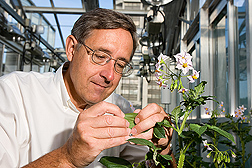True Origins of Widely
Used Potato Germplasm Revealed
|
|
Thanks to Agricultural Research Service botanist David Spooner and cooperators, potato breeders around the world now know the truth: some of the germplasm they’re using to develop new cultivars doesn’t come from where they thought it did.
Spooner, who is with the Vegetable Crops Research Unit in Madison, Wisconsin, and Marc Ghislain and other colleagues at the International Potato Center in Lima, Peru, recently discovered that potato germplasm called “Neo-Tuberosum” has origins that can be traced to southern lowland Chile, not the Andes as previously believed.
Native or “landrace” potatoes grow in two areas: lowland Chile and the Andes mountains, from western Venezuela south to northern Argentina. These cultivar groups of potato, Solanum tuberosum, differ mainly in day-length adaptation, that is, the number of hours of daylight needed for them to “tuberize,” or begin to develop potatoes.
The Andean potato, S. tuberosum Andigenum Group, is adapted to short-day conditions widespread in the Andes mountains. On the other hand, the Chilean potato, S. tuberosum Chilotanum Group, thrives in the long-day conditions farther south, which makes it preadapted to grow in other long day-length environments like Europe and North America.
The Andean potato contains many desirable traits, such as resistance to viruses X and Y, earlier tuberization, and greater yield. In the 1960s, English potato breeder Norman Simmonds sought to take the Andean potato and adapt it for use in long day-length regions. This new potato germplasm was named “Neo-Tuberosum” and is widely used by potato breeders around the world to develop new potato varieties.
Spooner and his colleagues had originally sought to measure how much the genetic base of modern potato varieties and breeders’ lines had broadened with respect to the Andean and Chilean landraces. The team used microsatellite genetic markers—tools used by taxonomists to distinguish closely related species—to genotype 193 potato varieties and breeders’ lines and help distinguish Andean varieties from Chilean varieties.
These efforts revealed that all six “pure” Neo-Tuberosum clones of the original populations generated by Simmonds and 33 varieties or breeders’ lines with an Andigenum pedigree contain plastid DNA markers typical of Chilotanum germplasm. This finding means Neo-Tuberosum germplasm is not strictly a product of interbreeding among Andean potatoes.
“Scientists who study the evolutionary history of an organism will need to reconsider the evolution of cultivated potato species,” says Spooner. “This discovery points to a larger series of questions that may change our knowledge of potato classification and identification.”
According to Spooner, breeders can now re-examine the value of the material from the Andean potato and will hopefully use it to develop new varieties with traits both farmers and consumers want.—By Stephanie Yao, Agricultural Research Service Information Staff.
This research is part of Plant Genetic Resources, Genomics, and Genetic Improvement, an ARS national program (#301) described at www.nps.ars.usda.gov.
David Spooner is with the USDA-ARS Vegetable Crops Research Unit, 1575 Linden Dr., Madison, WI 53706; (608) 890-0309.
"True Origins of Widely Used Potato Germplasm Revealed" was published in the May/June 2010 issue of Agricultural Research magazine.







